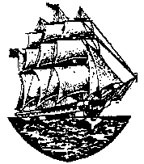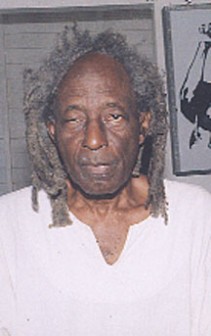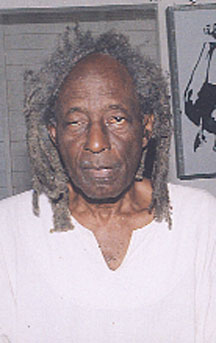By Estherine Adams
This article is an excerpt of a much broader body of work that focuses on Eusi Kwayana and his role in the national political developments of British Guiana, between 1950 and 1961. This article, the first of two, examines the circumstances that facilitated his emergence as a leading village politician in the Village of Buxton in the late 1940s and early 1950s.
Village and local government politics was a nursing ground for many who emerged to participate in the national struggle, especially in leadership roles. Thus, Kwayana’s first foray into politics came at the village level. This was to lay the foundation for his activities in the national political arena.
His first opportunity to participate in village politics at a visible level came around 1943, when a member of the Village Council, Mr. George A. Young, sent out the alarm that a letter from Enmore Estates Limited was to be read at the monthly meeting of the village council of Buxton-Friendship. Kwayana recollects that the meeting, “began at about 4:30 pm or 5 p.m., and the hall was full of villagers when it began….because the villagers were well aware of the ways the estate as we called it tried to push things down our throats. The District Commissioner, Mr. Amherst a Guyanese mulatto gentleman was present at the meeting.”
 The letter read aloud by the Clerk or Village Overseer, informed the Council that Lusignan factory was to be temporarily closed for repairs and that pending the completion of the repairs Enmore Estates would seek permission to take the canes from Plantation Lusignan immediately west of Buxton through the Right of Way canal to the factory at Enmore. Many villagers were employed in Lusignan, both in field and factory. The factory workers would be the ones principally affected by the temporary closing of Lusignan factory. Most villagers suspected that the closure would be permanent, which would mean a drop in the number of villagers who could get employment and training in the sugar factories.
The letter read aloud by the Clerk or Village Overseer, informed the Council that Lusignan factory was to be temporarily closed for repairs and that pending the completion of the repairs Enmore Estates would seek permission to take the canes from Plantation Lusignan immediately west of Buxton through the Right of Way canal to the factory at Enmore. Many villagers were employed in Lusignan, both in field and factory. The factory workers would be the ones principally affected by the temporary closing of Lusignan factory. Most villagers suspected that the closure would be permanent, which would mean a drop in the number of villagers who could get employment and training in the sugar factories.
Although Bookers Ltd., the owner of Plantations Enmore and Lusignan, tried to conceal the fact, there was a move to centralize sugar factories in all cane sugar producing countries. The aim was to raise the output of sugar with fewer factories. The fears were well founded as Lusignan factory never resumed grinding operations.
By 1945, local government was ‘almost dead’, especially in rural areas as its members provided no real leadership. The villagers in Buxton were increasingly alienated from the unprogressive village councillors, who were seen as “the preserves of the rural middle class”, and were generally more conservative than their urban counterparts”. The village councillors, “all fully adult and at that time all men…were very eloquent, but the majority of them were apologists for Sugar.” The one exception was George A. Younge, who was very suspicious of the plantocracy. He kept some of the younger non-councillors and non-ratepayers informed of the developments.
 The District Commissioner, a powerful government official who among other duties acted as a buffer between plantation managements and village councils, was usually on the side of the estates. He was viewed as mostly ‘ineffectual and almost totally ignored by all.’ The villagers did not see the District Commissioner as their advocate. This officer was regarded with the highest suspicion and was often held responsible along with some nominated councillors for betraying the village to the authorities, whether in the state or in big business. District Commissioners in the sugar belt were uniformly pro-sugar in their dealings.
The District Commissioner, a powerful government official who among other duties acted as a buffer between plantation managements and village councils, was usually on the side of the estates. He was viewed as mostly ‘ineffectual and almost totally ignored by all.’ The villagers did not see the District Commissioner as their advocate. This officer was regarded with the highest suspicion and was often held responsible along with some nominated councillors for betraying the village to the authorities, whether in the state or in big business. District Commissioners in the sugar belt were uniformly pro-sugar in their dealings.
It was in situations such as these that Martin Stephenson, and the then Sydney King began to call the villagers together and to discuss village affairs at public street corner meetings at Company line top. To explain how this was done, Kwayana is worth quoting at length:
Meetings were summoned by means of the village bell-crier Mr. Gill, mainly on Friday nights. Then the meetings moved from one segment of the village to the other, so that the whole village could look forward to meetings. The crowd came with benches and would stand for a good two hours at a time listening to the two speakers whom the adults fondly called the two small boys. The activities of the two speakers, who were both school teachers at the time, began to be noted by the authorities in the city. They discussed the local situation in detail and heard comments from farmers.
These agitation and educational activities were aimed at exposing the lack of alertness on the part of most of the older village councillors and their pro-sugar politics.
This move effectively launched their local political careers, which was consolidated with the formation of the Buxton Ratepayers’ Association. Ratepayers’ Associations served as forums for independent grassroots action while providing training for leaders. In this period they reflected the first signs of a new consciousness among the masses.
The immediate situation that led to the formation of the organization was the attempt by Bookers, the sugar monopoly company, to ‘wrest’ a ninety-nine year lease of a transport canal, popularly called the ‘right of way’, from the Buxton-Friendship Village council and “against the wishes and commonsense of the villagers.” According to Kwayana, “Bookers…was attempting to secure by devious means a 99 year lease to part of the village farm lands so that they could transport, in addition to the usual harvested sugar canes, manufactured sugar to the city by waterways, thus crippling the revenues of the railway system, which was owned by the government.” Progressive opinion felt that the canal would compete with the railway system and undermine the village economy. The issue was a clash between the interests of villagers and those of planters, and the present village councillors, it was believed, were preparing to align themselves with planters.
This issue surfaced as a result of a request by the District Commissioner that the issue be decided once and for all by the end of 7th October, 1949. According to the Argosy, it placed the village in a state of “ferment”, and led to a series of meetings at street corners and public halls to discuss the matter of the lease. Considerable discussion took place at a public meeting held at the village hall, on 25th August, 1949, on the need for forming a Ratepayers’ Association. M.G. Sankies presided and M. Newton, S.E. King and M.J. Stephenson convened. Newton explained the objective of the meeting and urged the necessity for such an association, especially in the current situation. Several prominent villagers spoke supporting the idea, and it was decided to call another meeting to elect office-bearers.
The Buxton Ratepayers Association was thus founded by the then Sydney King and Martin J. Stephenson, along with Albert Henry, Sheer Khan, S.I.A. Glasgow, I.A. Glasgow, Veta Griffith, Seepaltan and Vernon Henry. The Association was described as a grassroots watchdog effort over the conduct of village affairs by the local council and the government. It must be noted at this juncture that the present Village Council did not recognize the Association, but the Association was by no means fazed by this. It continued to work on behalf of the people of the village.
The newly formed Association took a firm stand against the lease and submitted, what the Argosy termed, an ‘exhaustive memorandum’ to the Village Council, “asking that discussion of the question be suspended until the publication of the Venn Commission Report.” This report came in the wake of the Enmore incident and was an examination of the problems facing the sugar industry. The Association also enlisted the help of Mr. Paul Slowe, an ex-Chairman of Beterverwagting, who at a crowded meeting at the Tipperary Hall “exhorted Buxtonians to oppose the lease vigorously in the interest of their future independence.”
The Association grew into the authentic representative of the villagers on all issues, and even led successful opposition to the Central Drainage Board, which refused to provide proper drainage, thus precipitating six floods in the village in 1949. These crises consolidated the then Sydney King’s and the Ratepayers’ Association position as bona fide leaders of the village.
The control of drainage and how much or how little drainage the village would receive was in the hands of the Drainage and Irrigation Board called the Drainage Board. During the 1949-1950 periods the head of the sugar estate was the head of the Drainage Board. Buxton, like many other East Coast Demerara villages were prone to flooding. In the year 1949 the village experienced five major floods. Things climaxed in December 1949 when the villagers could no longer take it.
In December 1949 very serious flooding was caused in the Colony by the prevailing heavy rains. This situation was exacerbated for Buxton which was located between Plantations Lusignan and Nonpareil. These estates had the habit of dumping their excess water on the village by various devices. They regarded keeping the sugar fields dry as a priority, but this policy was the opposite for a farming village growing both sugar cane and food crops.
The situation, which was approaching the stage of a crisis, was officially brought to the attention of the Legislative Council on 30th December 1949 by Dr. Cheddi Jagan who was the elected representative for Central Demerara. Dr. Jagan observed that although “there is no doubt the heavy rainfall has to a great extent contributed to the very serious situation existing there at the present time, but in certain places there are other conditions which, I feel, should be immediately gone into so that relief can be brought in this distressed area.” Dr. Jagan pointed to Buxton and proceeded to explain that the water from Lusignan and Nonpareil was seeping through the defective pegasse dams and “at the present time [the] township area is being flooded through the water overflowing the very dams themselves.” He recommended that some emergency operations be done in the area, the reconstruction of the dams be immediately embarked upon and the natural drainage given attention.
The Buxton-Friendship village was threatened with a serious inundation and there were few houses with a dry approach. As reported by the Daily Chronicle, the water was “far above the knee and save for the Buxton Company Road, all the main thoroughfares leading to the railway station have become impassable without a pair of Wellingtons.” The floods had a destructive effect on farmers in the village, whose crops such as ground provisions rotted. This led to shortage of food and increased prices for certain commodities. It also affected adversely sanitation in the village as many villagers used latrine toilets. Thus, a “watch had to be kept for the appearance of certain diseases in the form of mild epidemics.”
After the water had sat on the land for over twenty-one days, two young men who had discussed the situation on their way home from Georgetown on the mid-day omnibus train decided to visit the outfall area which would release the flood waters to the Atlantic Ocean. These two young men were Narine Persaud (Baba) and the then Sydney King. They found that the Buxton sideline koker had been effectively barred, on orders of the Drainage Board, so that it could not open.
Buxtonians, who as stated in the Daily Chronicle, “never took things lying down when their interests were at stake”, and “even at the point of opening themselves to prosecution”, did not disappoint this time. Kwayana and some other villagers decided to take matters into their own hands as an act of self preservation, to get rid of the unwanted water. It was 31st December, 1949, ‘Old Year’s Day’ and the incident became known in village history as “Contention Koker”.
After the problem was ascertained, Kwayana and Persaud left to mobilize shovel men to open the disused Buxton koker, which they claimed, would effect an immediate discharge of the water. Needless to say, all races of villagers turned out to support the action. At the scene, the District Engineer Mr. Comacho, representing the Drainage Board, was of the opinion that “the koker was not good and if raised, might collapse and not be closed again.” The villagers contended that the koker was a new one, recently put down and could not be rotten. The Board had closed it down for reasons unknown to them.
Mr. Comacho tried in vain to prevent the villagers’ efforts and resorted to police force. Sergeant Talbot along with two Constables of the Vigilance Police Station arrived, and as was reported in the Daily Chronicle, they “made a great show of “business”…but his Constables held rather aloof and seemed to have known better.”
The plan of the villagers succeeded as near midnight the koker door was opened and the water started to tumble seawards, to the “lusty cheering of the crowd”. According to Kwayana, “the police and officials looked on eagerly; waiting for the structure to collapse…it hardly vibrated.” Within a couple of hours, water-marks showing decrease were seen and Engineer Comacho’s theory was proved wrong all around.
A similar incident took place later which shows the ingenuity and versatility of Kwayana’s leadership. This incident involved five males from the village in a midnight effort to again relieve the village of drainage water. These men were Ucil Dundas, Albert Sobers, Felix Hamer, Rigby Dover and Sydney King.
Nonpareil estate lays on the eastern flank of Friendship, bounded by a common dam, the Friendship East Side Line dam and to the east of that a sideline trench, which was for drainage. The east sideline dam was used by small farmers for cultivation. The advantage of growing crops on a dam was that it would be the last place to be flooded. When the heavy rains began the village was faced with the problem of getting rid, as quickly as possible, of the excess water.
Farmers returning from their farms in Friendship began to report that the water from the sideline trench on the Nonpareil side was rising because a massive stop had been built in the Nonpareil sideline trench. This stop-off checked the free flow of water from a vast area of Nonpareil cane fields to the sea and the estate’s drainage pump. Blocked in a forward flow, the water could only rise and flow over to Friendship and into the estate’s cane fields. There was general alarm among the farmers as their industry was in danger of being wasted. On the other, it was convenient for estates to flood their cane field at that time.
The regular thing for the villagers to do would have been to report the matter to the District Commissioner, but as alluded to before, the District Commissioner usually sided with the estates. Thus, the previously named villagers “held counsel and decided on a course of action which was not one in which the population could be involved.” This was unlike the preceding flooding incident that was examined, where the entire village was mustered to assist in the effort. Instead, the five left the village one night “at midnight with torch lights, shovels and forks, walked the five miles to the stop-off, which had been inspected during the day, and broke it down.” The village, as a result, was relieved of the threat of flooding.
These incidents demonstrated the then Sydney King’s ability to adapt to given situations, especially when it involved the welfare of his fellow villagers. When the situation called for the entire village, he was able to rally the villagers. Conversely, when the situation called for a few men to work with speed and furtiveness, he was able to find these men. This, undoubtedly, is an admirable quality in any leader. In the writer’s estimation, these incidences should not be regarded as a flouting of authority, for people, faced with flood waters all around them, the destruction of their livelihood and threats to their health, would want to try any possible means of getting rid of the water. These traits would serve him well in his national political endeavours.





